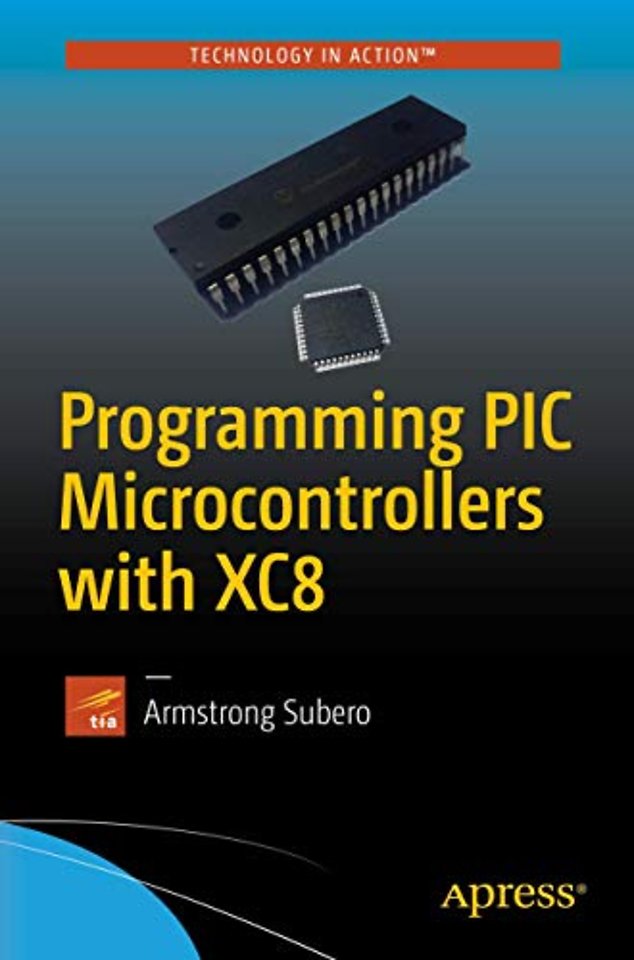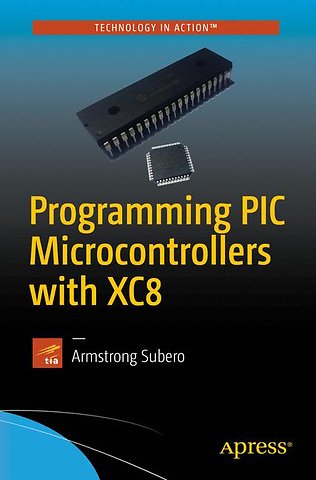Programming PIC Microcontrollers with XC8
Paperback Engels 2017 9781484232729Samenvatting
Learn how to use microcontrollers without all the frills and math. This book uses a practical approach to show you how to develop embedded systems with 8 bit PIC microcontrollers using the XC8 compiler. It's your complete guide to understanding modern PIC microcontrollers.
Are you tired of copying and pasting code into your embedded projects? Do you want to write your own code from scratch for microcontrollers and understand what your code is doing? Do you want to move beyond the Arduino? Then Programming PIC Microcontrollers with XC8 is for you! Written for those who want more than an Arduino, but less than the more complex microcontrollers on the market, PIC microcontrollers are the next logical step in your journey.
You'll also see the advantage that MPLAB X offers by running on Windows, MAC and Linux environments. You don't need to be a command line expert to work with PIC microcontrollers, so you can focus less on setting up your environment and more on your application.
What You’ll Learn
-Set up the MPLAB X and XC8 compilers for microcontroller development
-Use GPIO and PPS
-Review EUSART and Software UART communications
-Use the eXtreme Low Power (XLP) options of PIC microcontrollers
-Explore wireless communications with WiFi and Bluetooth
Who This Book Is For
Those with some basic electronic device and some electronic equipment and knowledge. This book assumes knowledge of the C programming language and basic knowledge of digital electronics though a basic overview is given for both. A complete newcomer can follow along, but this book is heavy on code, schematics and images and focuses less on the theoretical aspects of using microcontrollers. This book is also targeted to students wanting a practical overview of microcontrollers outside of the classroom.
Specificaties
Lezersrecensies
Inhoudsopgave
Chapter One: Preparing For DevelopmentA short intro chapter focused on telling the reader tools and software that will be needed• Gathering Your Hardware• Microcontroller• Programmer• Gathering the Software• Setting Up Shop• Multimeter• Oscilloscope• Power Supply• Shopping for Supplies• Conclusion
Chapter Two: The C Programming LanguageFocused on reviewing the basics of the C programming language for those familiar and providing a basic overview for absolute beginners• 2.1 C• 2.2 C Programming• 2.2.1 C program Structure• 2.2.2 Comments• 2.2.3 Variables and Constants• 2.2.4 Arrays, Pointers and Structures• 2.2.5 Operators• 2.2.6 Controlling Program Flow• 2.2.7 Preprocessor Directives• 2.3 Assembly vs C• Conclusion
Chapter Three: Basic Electronics for Embedded SystemsReviews basic electronics components and their functions as it relates to embedded systems while avoiding too much complex theory and providing practical applications usually skipped in other books eg logic level conversion• 3.1 Electronics• 3.2 Resistors• 3.3 Potentiometer• 3.4 Photoresistor• 3.5 Capacitor• 3.6 Inductor• 3.7 Transformers• 3.8 Diode• 3.9 Transistor• 3.10 Operational Amplifier• 3.11 Digital Electronics• 3.13 Logic Level Conversion• Conclusion
Chapter Four: PIC® MicrocontrollersProvides everything the user will need to know about PIC microcontrollers by presenting the architecture concisely in a plain context presenting basic information (eg what is a pin) all the way to the CPU core without using irrelevant detail beyond what is needed to use the device. • 4.1 PIC® Microcontrollers Overview• 4.2 PIC® 16F1717 block diagram• 4.3 Program Flash Memory• 4.4 Random Access Memory• 4.5 Timing Generation• 4.5 !MCLR• 4.6 PORTS• 4.7 On Board Peripherals• 4.7.1 Analog to Digital Converter• 4.7.2 Digital to Analog Converter• 4.7.3 Capture Compare Pulse Width Modulation Module• 4.7.4 Timers• 4.7.5 Comparators• 4.7.6 Fixed Voltage Reference• 4.7.7 Temperature Indicator• 4.7.8 EUSART• 4.7.8 CLC• 4.7.9 MSSP• 4.7.10 NCO• 4.7.11 ZCD• 4.7.12 COG• 4.7.13 Operational Amplifiers• 4.7.14 High Endurance Flash Block• 4.8 The Enhanced Mid-Range CPU Core• 4.8.1 Power-up Timer• 4.8.2 Oscillator Start-up Timer• 4.8.3 Power-on Reset• 4.8.4 Watchdog Timer• 4.8.5 Brown-out Reset• Conclusion
Chapter Five: Input and OutputCovers the basics of I/O including PPS, interfacing LEDs, pushbuttons and seven segmentdisplays.• 5.1 Let’s Begin I/O• 5.2 TRIS Register• 5.3 PORT Register• 5.4 Output Latch Registers• 5.5 Analog Select Registers• 5.6 Weak pull-up• 5.7 Making an LED Blink• 5.8 Using a Pushbutton• 5.9 Seven Segment Displays• 5.10 Seven Segment Display Multiplexing• 5.11 Project: Countdown Timer• 5.12 Peripheral Pin Select• 5.13 Conclusion
Chapter Six: Interfacing ActuatorsDemonstrates using actuators DC motors, servos and stepper motors.• 6.1 Introducing Actuators• 6.2 DC Motor• 6.3 Servo Motor• 6.4 Stepper Motor• Conclusion
Chapter Seven: Interrupts, Timers, Counters and PWMExamines the use of Interrupts, Timers, Counters, PWM and the RGB LED• 7.1 Introduction to Interrupts• 7.2 Timers• 7.3 Timer0 in Timer Mode• 7.4 Timer0 in Counter Mode• 7.5 Timer0 with Interrupts• 7.6 CCP Module• 7.7 Understanding PWM• 7.8 Using PWM• 7.9 Project: Using PWM with a Motor Driver• 7.10 Project: Using CCP and dedicated PWM with RGB LED• Conclusion
Chapter Eight: USART, SPI and I2CPresents the use of serial communication protocols including USART with GPS and GSM,SPI and I2C.• 8.1 Serial Communication Protocols• 8.2 USART• 8.3 Serial Character LCD• 8.4 UART to PC Communication• 8.5 Text To Speech• 8.6 GPS• 8.7 NEMA Commands• 8.8 Software USART• 8.9 GSM Module• 8.10 AT Commands• 8.11 SPI• 8.12 Digital Potentiometer• 8.13 Character Display• 8.14 Character: The Hitachi HD44780 LCD• 8.15 The Samsung KS0066U• 8.16 I2C• 8.17 EEPROM• Conclusion
Chapter Nine: Interfacing DisplaysLooks at using displays including the SSD1306 and Nextion Touch Screen Displays• 9.1 Displays• 9.2 OLED Display• 9.3 Touch Screen LCD• 9.4 Resistive Touch• 9.5 Capacitive Touch• 9.6 Selecting a Touch Screen LCD• 9.7 Using the Touch LCD• 9.8 Create a layout• 9.9 Adding Widgets• 9.10 Adding Code• 9.11 The Result• 9.12 Read on Microcontroller• Conclusion
Chapter Ten: ADC and DACConsists of understanding the ADC and DAC• 10.1 Data Conversion• 10.2 ADC• 10.3 Project: Digital Thermometer• 10.4 DAC• Conclusion
Chapter Eleven: CLC, NCO, Comparator and FVRCovers using the onboard peripherals of the CLC, NCO, Comparator and FVR• 11.1 CLC• 11.2 NCO• 11.3 Comparator• 11.4 FVR• Conclusion
Chapter Twelve: Wi-Fi and BluetoothTakes us into the wireless connectivity with Wi-Fi and Bluetooth• 12.1 Low Cost Wireless Connectivity• 12.2 Wi-Fi• 12.3 The ESP8266• 12.4 Testing the ESP8266• 12.5 Project: Wi-Fi Data Logger• 12.6 Bluetooth• 12.7 Using the HC-05• Conclusion
Chapter Thirteen: Watchdog Timer and Low PowerDemonstrates use of low power features of the microcontroller, minimizing power consumption and the WDT• 13.1 Low Power 8 bit vs 32 bit• 13.2 SLEEP Mode• 13.3 Watchdog Timer• 13.4 Other Ways to Conserve Power• 13.5 Reduce the Clock Frequency• 13.6 Reduce the Operating Voltage• 13.7 Power External Devices from I/O Lines• Conclusion
Chapter Fourteen: PIC® Microcontroller ProjectsA project based chapter where we build two projects• 14.1 Project: Temperature Controlled Fan• 14.2 Project: Touch Screen Clock• Conclusion
Anderen die dit boek kochten, kochten ook
Rubrieken
- advisering
- algemeen management
- coaching en trainen
- communicatie en media
- economie
- financieel management
- inkoop en logistiek
- internet en social media
- it-management / ict
- juridisch
- leiderschap
- marketing
- mens en maatschappij
- non-profit
- ondernemen
- organisatiekunde
- personal finance
- personeelsmanagement
- persoonlijke effectiviteit
- projectmanagement
- psychologie
- reclame en verkoop
- strategisch management
- verandermanagement
- werk en loopbaan







